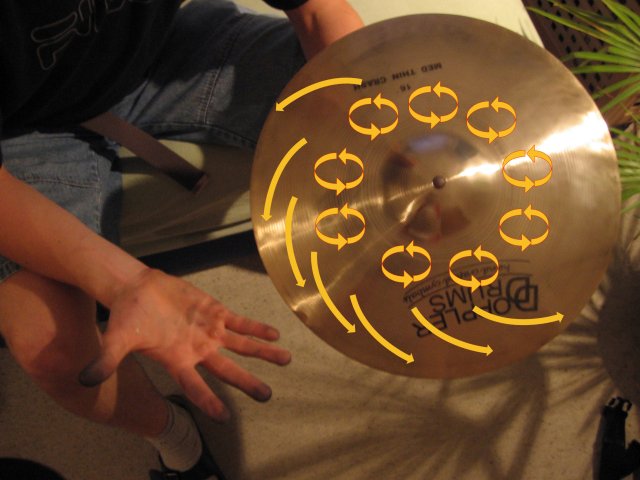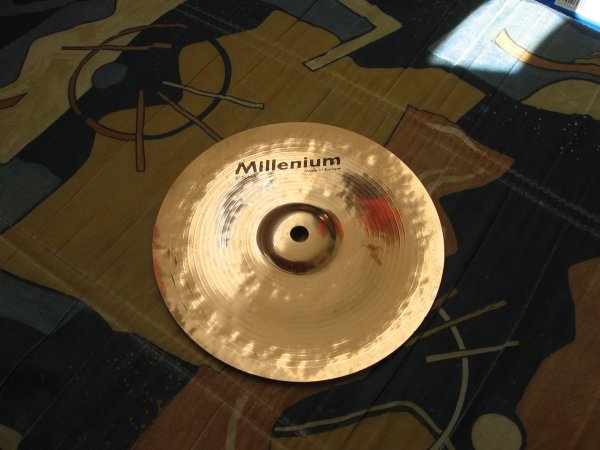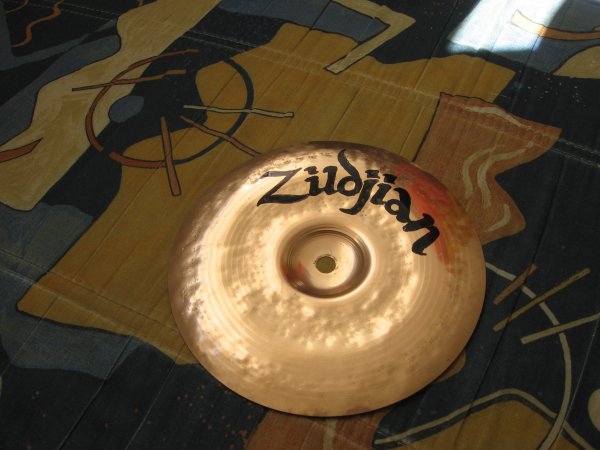in etwa so, nur die Rückseite, oder was?

Vorsicht, so nicht!
Caution! Do not hammer like this!
in etwa so, nur die Rückseite, oder was?

Vorsicht, so nicht!
Caution! Do not hammer like this!
Nö, ich meinte in Kreisen, die parallel zum Kuppenrand sind. Wobei, ausgehend davon sehen die "Strahlen" bei Dir cleverer aus, da ja so innen automatisch mehr gehämmert wird als außen. Lass die kleinen Kreise innen weg und mach das andere, dann müsste das theoretisch hinhauen.
Gruß
Alex
ZitatOriginal von zorschl
So ist es, also rund um die Kuppe mehr hämmern als nach außen hin. Dadurch erreicht man allerdings, dass das Becken innen dünner wird als außen, was ja eigentlich nicht der Fall sein sollte. Hast Du eine Möglichkeit, das Becken hinterher abzudrehen? Ich glaube, auf cymbalholics.com hat mal jemand beschrieben, wie man sich eine entsprechende Drehbank selber bauen kann. Ich kann mir vorstellen, dass man mit der Anordnung der Hammerschläge auch beinflussen kann, in welche Richtung sich das Material ausdehnt, z.B. wenn man innen in koaxialen Kreisen arbeitet, dürfte sich das Material nicht zum Rand hin ausdehnen, während man nach außen hin mehr in radialen Strahlen arbeiten müsste, um die Wölbung zu erhalten aber trotzdem das Material zu verdichten. Johan möge mich korrigieren, wenn ich Quatsch schreibe...
My knowledge of the German language is a bit too basic to really understand everything you are writing...but ehm...sorry...I'm afraid it does indeed look a bit like Quatsch ![]()
![]()
Every hammerstroke makes the metal a little bit thinner and thus expands the metal, regardless of the direction in which you work or where you start. Bronze is not like clay or a tube of toothpaste...
Anyhow hammering is not the method to control the thickness of cymbals. That's what a lathe is meant for.
And yes you can build a lathe yourself if you just copy the principle of a simple Turkish cymbal-lathe.
ZitatOriginal von Johan VDS
I'm afraid it does indeed look a bit like Quatsch
AWESOME! ![]()
![]()
![]()
Well I have to stay a LITTLE bit polite, don't I ?? ![]()
It' okay, I can handle this... ![]() I ment the following: Of course every stroke makes the material thinner and it expands equally around the center of the stroke. But, if I hammer a line, the material will expand mainly in direction of the line, right? So, if I hammer in circles parallel to the cup, the material will expand in direction of the circles mainly and just a bit in the direction of the radius.
I ment the following: Of course every stroke makes the material thinner and it expands equally around the center of the stroke. But, if I hammer a line, the material will expand mainly in direction of the line, right? So, if I hammer in circles parallel to the cup, the material will expand in direction of the circles mainly and just a bit in the direction of the radius.
The mistake I did in mind was, that I thougt that a bow generally needs more surface (equal more hammering) close to the cup. It just needs more surface at the place, where the cymbal is supposed to bend downwards, so it's depending on the shape the cymbal should have.
Second mistake was, that I thought, hammering is also to control the thickness. After all, I never hammered a cymbal succesfully into a better sound, I just tried to imagine what I would do to reach the requested result. At least I'm happy for every correction by you, because it will increase my knowledge...
kind regards
Alex
ZitatOriginal von zorschl
So, if I hammer in circles parallel to the cup, the material will expand in direction of the circles mainly and just a bit in the direction of the radius
You will indeed get a bow shape if you hammer several circles. But to get a more pronounced bow you'll need to hammer in between the circles as well.
ZitatOriginal von buddler
I will post some pics when my parents (and cam) are back from their holiday.
Are they still on holiday ? ![]()
First Trial:
I converted a crappy Millenium 8'' Splash into a nice Zildian Mini China ![]()

and now:
Cool ! And a soundfile perhaps ??
Der Zildjian Schriftzug dadrauf ist ja mal zu geil ![]() hätte auch gern was Hörbares, eventuell ein Vorher/Nachher?
hätte auch gern was Hörbares, eventuell ein Vorher/Nachher?
ZitatOriginal von Johan VDS
Cool ! And a soundfile perhaps ??
Unbedingt!!! Das umlabeln hat ein bisschen was alchemistisches: Blei->Gold, Millenium->Zildjian... ![]()
Gruß
Alex
ZitatOriginal von buddler
It is about 30 cm, but real crap right now...
I don't know the material exactly, but it is some kind of red bronze (maybe b8 ).
I will post some pics when my parents (and cam) are back from their holiday..
Show us a pic of this one...
hast du zufällig ein paar bilder davon gemacht wie du das becken gehämmert hast? ich hab nämlich auch noch so n altes millenium splash rumfahren und hätte auch extrem bock auf so ein mini china ![]()
EDIT: und vor allem, wie hast du das so "brilliant" gekriegt?^^
becken rumdrehen, anmalen. super job.
I have a question, Johan.
I've bought a Stagg Traditional China (22") for quite little money and would like to add a bunch of rivets.
Now I'm wondering how many I should use, where to place them and of which material they prefarably should be.
In Hugo Pinksterboer's "Cymbal Book" I've read, that you should place them either about 1 inch from the edge or right in the "fold".
I've also seen chinas that were riveted on the "shoulder".
What would be your suggestion for a low, warm (but still trashy) and sustaining sizzled china sound (I imagine to use it in ballads.)
I'll add some pictures to give you an idea about the cymbal's "architecture".


De groeten van
Sven
ZitatOriginal von drumsandbeats
I've bought a Stagg Traditional China (22") for quite little money and would like to add a bunch of rivets.
Now I'm wondering how many I should use, where to place them and of which material they prefarably should be.
What would be your suggestion for a low, warm (but still trashy) and sustaining sizzled china sound (I imagine to use it in ballads.)
First of all I'd try with a bathtub chain. If that sound pleases you, you don't have to drill and risk to damage this already fragile cymbal.
If you do want rivets I'd suggest starting with only one or two rivets about 1,5 inch away from the edge (never in the fold). You can always add more later.
It's very important that the metal does not get hot while you are drilling, so use good tools and cool the metal or drill in several steps.
The material of the rivets is a matter of taste. Steel rivets will add a brighter sizzle than brass rivets. Experiment.
But rivets are not going to change the character of the cymbal. It's not going to make the cymbal warmer or lower. They just add a high frequency sustain.
Groeten van Johan :]
dachbodenfund, kann ich die versuchen zu hämmern oder sagen euch die folgenden becken was?
man kann es schwer erkennen, aber das hier müsste ein medium 16" crash der firma "ZYMEOR" sein. sagt wem das was?

ok, ufip klar, aber hatten die auch ne ultrabilligserie?*g*
das hier ist ein 16" crash. klingt besser, als das "ZYMEOR"

so und dann hab ich noch ein paar 15" hi-hats von "TOSCO" made in italy.
bottom und head sind sehr schwer und dick.
kann jemand mit irgendeinem der becken etwas anfangen, oder kann man an denen ruhig ma rumkloppen?
danke für die antworten!
The Tosco hihats are B20 and professional quality. Without experience, you'll probably break these. It 's a very hard B20 variety. They can be made into much more beautiful cymbals but you really need to know what to do.
The other cymbals would be good for learning. The Ufip looks like a cheap B8 cymbal, the Zymbor (not Zymeor) looks like brass.
Du hast noch kein Benutzerkonto auf unserer Seite? Registriere dich kostenlos und nimm an unserer Community teil!


